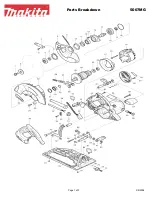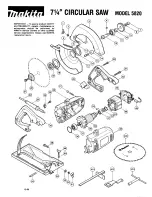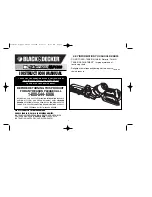
10
WARNING:
When servicing use only identical Ryobi replacement parts. Use of any other parts may create a hazard or cause
product damage.
GENERAL
Avoid using solvents when cleaning plastic parts. Most
plastics are susceptible to damage from various types of
commercial solvents and may be damaged by their use.
Use clean cloths to remove dirt, carbon dust, etc.
WARNING:
Do not at any time let brake fluids, gasoline, petro-
leum-based products, penetrating oils, etc. come in
contact with plastic parts. They contain chemicals
that can damage, weaken, or destroy plastic.
Electric tools used on fiberglass material, wallboard,
spackling compounds, or plaster are subject to
accelerated wear and possible premature failure, as the
fiberglass chips and grindings are highly abrasive to
bearings, brushes, commutators, etc. Consequently, we
do not recommended that this tool be used for extended
work on these types of materials. If, however, you do
work with any of these materials, it is extremely important
that you clean the tool frequently by blowing it with an air
jet.
MAINTENANCE
WARNING:
Always wear safety goggles or safety glasses with
side shields during power tool operation or when
blowing dust. If operation is dusty, also wear a dust
mask.
LUBRICATION
All of the bearings in this tool are lubricated with a
sufficient amount of high grade lubricant for the life of the
unit under normal operating conditions. Therefore, no
further lubrication is required.
OPERATION
Fig. 7
6
METAL CUTTING
See Figure 7.
You may cut metals such as sheet steel, pipe, steel rods,
aluminum, brass, and copper with your saw.
Observe the following tips when metal cutting.
■
Be careful not to twist or bend the saw blade.
■
Do not
force the tool.
■
Use cutting oil when cutting soft metals and steel.
Cutting oil also keeps the blades cool, increases
cutting action, and prolongs blade life.
■
Never
use gasoline since normal sparking of motor
could ignite fumes.
■
Clamp the workpiece firmly and cut close to the
clamping point to eliminate any vibration of the work.
When cutting conduit pipe or angle iron, clamp the
workpiece in a vise if possible and cut close to the
vise. To cut thin sheet material, “sandwich” the ma-
terial between hardboard or plywood and clamp the
layers to eliminate vibration and material tearing.
■
Always keep firm pressure on the base to hold it
securely against the workpiece.
Содержание RJ161V
Страница 11: ...11 NOTES ...






























